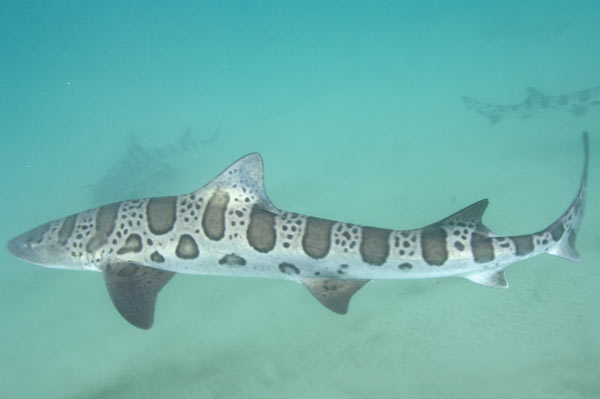
Diet:
Hunts over sand in search of burrowing invertebrates such as worms but will feed opportunistically on a wide variety of animals including crustaceans, squid, bony fishes, and small sharks and rays (mainly other smoothhounds, bat rays and guitarfishes).
Behavior:
The Leopard Shark sometimes forms nomadic schools with other species especially the Grey Smoothhound (Mustelus californicus) and Spiny Dogfish (Squalus acanthias). Usually maintains a small home range but can roam up to 150km. A strong swimming shark that can occasionally be seen resting among rocks.
Reaction to divers:
Skittish. Best approached on snorkel but difficult to get close to. Apparently easier to approach at night. Due to their small size Leopard Sharks do not pose a threat to divers or snorkellers. But a Leopard Shark was responsible for an attack on an Aquarium Diver (Dean Fessler of the Shark Research Institute) while he was feeding the sharks in front of a large group of spectators. The way Dean explains it, the offending Leopard Shark accidentally bit his cheek while attempting to take the bait which was floating free in front of Deans face. A large flap of skin was torn away resulting in a huge cloud of blood that terrified the crowd and put an abrupt end to the "most sharks aren't really dangerous" speech that he was conducting.
Diving logistics:
.

It is usually possible to find Leopard Sharks throughout the summer and early fall directly in front of the Marine Room Restaurant in La Jolla. Why the sharks like this spot isn't clear but it may simply be that they patrol the entire coastline and this is where the snorkellers enter the water to see them.
A good way to get closer to the sharks is to carry some fish but note that La Jolla is a protected area and feeding or harassing the marine life within the park is illegal.
Other diving locations submitted by readers:
Ron Clough (Organizer of the California Shark and Ray Count) suggests that any places where warmer than normal water flows into the sea (e.g. from power plants) Leopard Sharks are likely to be seen







